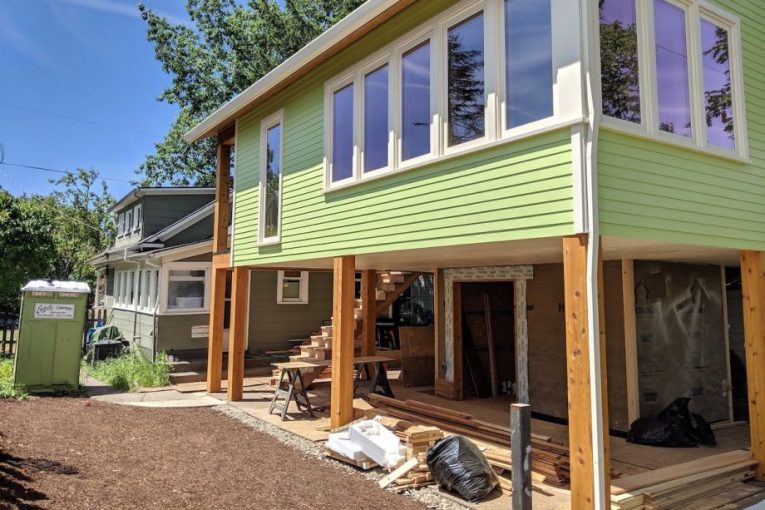

By David M. Greenwald
Executive Editor
ADUs have increasingly been viewed as a potential solution to the housing crisis. That makes sense as they can be affordable by design, they can be added to existing single-family lots, and they immediately add density.
On the other hand, critics have long noted that they are not true affordable housing because there is no restriction for resell or any guarantee that they will be rented at sufficiently low rates.
There was an interesting piece last week in Next City: “ADUs Can Help Address The Lack Of Housing. But They’re Bad Urban Design.”
Travis Beck, writing an op-ed, argues that while ADUs have been embraced as a “means to quickly address severe housing shortages,” when they are “implemented at scale,” ADUs are “a bad urban design solution.”
He argues, “They disrupt the neighborhoods they are intended to preserve and can limit, rather than create, social opportunity.”
Beck lives in such a neighborhood. He argues that given the housing crisis for low and middle-income Americans, “ADUs offer many advantages.”
For instance, he notes, “ADUs can be relatively quick to construct. They reduce sprawl and lower development costs by adding housing where utilities, roads, schools and services already exist. They address housing affordability both by creating more rental units and by generating income for the homeowners who rent them out.”
However, he argues, “The unspoken advantage for communities permitting ADUs as a housing strategy, however, is that they delay the day of reckoning with the land-use policies of the last century.”
And that turns out not to be such an advantage.
He continues that “tucking more people into the backyards and former garages of a single-family neighborhood preserves the dream of homeownership for only a segment of the population, cuts off access to neighborhood life for the rest — and puts everyone in an uncomfortable arrangement.”
He notes that ADUs are the secondary unit, located in the back of the property and thus, accessed through a gate.
“This arrangement creates two parallel neighborhoods. One is a front-facing neighborhood of homes with front yards and front porches,” he explains. “The other is a secondary neighborhood with no obvious street frontage, limited opportunities for neighborly relationship building, and design-enforced isolation.”
This creates a situation of perpetual strangers or two neighborhoods—one for the privileged and one for the less privileged.
Moreover, it is the property owner that possesses the power while “[f]inancial inequality is expressed spatially and then reinforced as differential access to the social networks of the neighborhood.”
In short, “It is an undemocratic arrangement.”
We might be able to live with that if it actually solved the housing problems.
Beck suggests, “There are better ways to add density while building opportunity and the community life of neighborhoods.”
One of these includes the duplexes that have been prioritized through SB 9.
He argues, “These building types put the residents of each unit on an equal footing. Importantly, by being front-facing, they also create equal access to the life of the neighborhood.”
He acknowledges, “So far, these reforms have led to only modest numbers of the newly permitted housing types being built. This slow uptake suggests that the inertia of the single-family neighborhood — due to whatever combination of market preference, the lifecycle of individual properties, or the parcel-by-parcel obstacles of small lots, mature trees, and other site constraints — may not be so easily overcome.”
He adds, “So while allowing gentle density is part of the solution, more direct measures may also be necessary to address America’s housing shortage.”
Beck concludes, “Cities need to take action to address housing shortages and declining affordability. Rather than pursue the seemingly easy option of permitting more ADUs, they should use the familiar built forms of denser neighborhoods to create housing and community for more of the population at the same time. That’s good planning and good urban design.”
Beck raises an interesting point. But he also acknowledges that so far SB 9 based solutions have come under fire from neighborhood groups while not adding a huge amount of housing—while ADUs have been less controversial and could be implemented more fully.
In either case, I see both solutions as temporary stopgap mechanisms. The larger solutions involve addressing income inequality, the housing crisis as a whole, and largely building new housing at a rate that can allow housing prices to track with incomes. Short of that, all we are actually doing with most of this is putting a bandaid on the problem.


Wanting this fantasy is what impedes making real progress. I first saw this in 1990 when NRDC proposed that we could gain large GHG emission reductions by densifying existing neighborhoods. I calculated that California would have to demolish 25% of its neighborhoods to accomplish the reductions that NRDC was proposing. Instead we must be realistic about what we’re trying to achieve.
Whether forward facing housing greatly increases social interaction is really speculative. It could be having multiple households one parcel actually increases social interaction (and greater neighborhood diversity) at a faster pace.